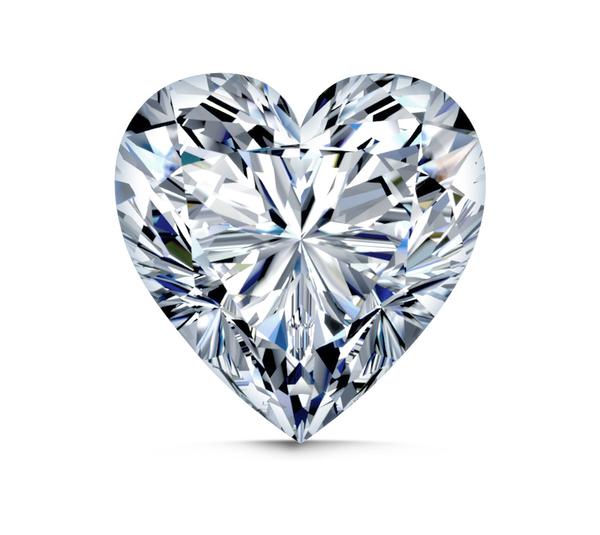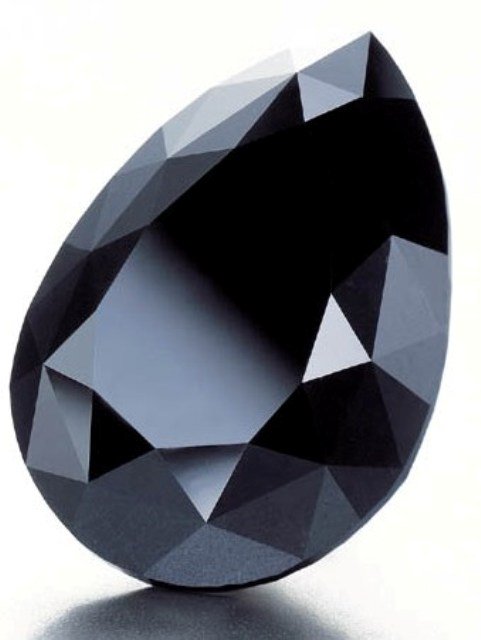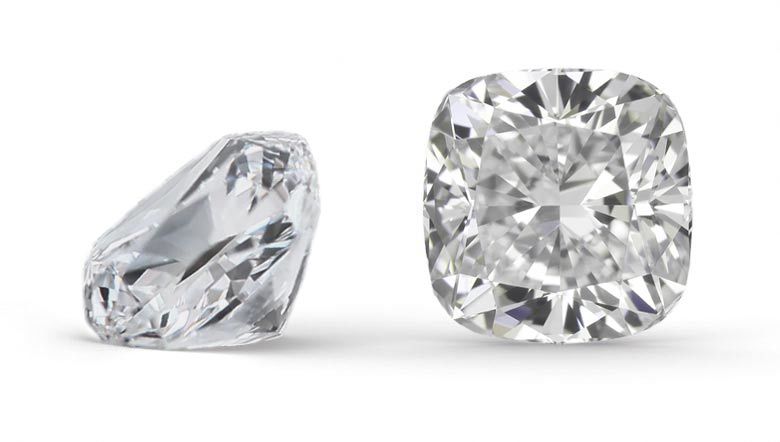If you’ve ever been in the market for jewelry, especially diamonds, then you’ve probably heard of the 4 C’s of diamond grading. Perhaps you, like most people, are still unsure of what all the details entail. When shopping for a new car, you’d want to know the car’s safety ratings, fuel efficiency, and horsepower. Similarly, before you even step inside a jewelry store (or visit a website) hoping to buy a diamond, you should know the basics of diamond grading.
The 4 C’s are cut, clarity, color, and carat weight. These factors are equally important when determining the cost of a diamond, but independent of each other. So unless you know all four, it’s impossible to compare one diamond to another. The Gemological Institute of America (G.I.A.) developed the criteria for diamond grading which has been adopted by the entire industry.
Cut

When we think of diamonds, we think of how they sparkle. It requires precise workmanship to create a stone that is proportionate and symmetrical, causing that sparkle to the eye that diamonds have become famous for. That’s one reason the cut grading is the most important criteria in diamond grading. A diamond cut to the ideal proportions will have a brilliant shine while a poorly cut diamond may appear dull and lifeless, even if the clarity, color, and carat are all ideal. There is a specific mathematic formula for the perfect diamond cut, and any small variation can affect the diamond grading.
The cuts of a diamond are called facets and can be thought of as mirrors. If positioned properly, the light will enter the diamond, bounce around these facets and leave at the viewer’s eye. The cut has to be precise for the light entering the diamond to bounce throughout the gem to create the sparkling effect. So precise, that if a single facet is not positioned properly, light leaks out of the diamond, never maximizing the sparkle and brilliance, ultimately falling short of its full optical potential. The diamond’s cut refers not only to the facets but also the symmetry, proportion, and finish (known in the trade as the “make”).
Different Styles Of Cuts
There are three basic styles of diamond faceting:
- Brilliant cut
- Step cut
- Mixed cut
The brilliant cut is designed to maximize diamond sparkle. Brilliant round cut diamonds are the most popular shape and cut. It uses many triangular and kite-shaped facets to shine as bright as possible. Most full-cut round brilliant diamonds have either 57 or 58 facets, depending on the diamond’s culet. The culet is the bottom-most point of the diamond. Some will have an extra cut down at the bottom. For example, a brilliant round diamond with a faceted culet has 58 facets, while a brilliant round diamond with a pointed culet has 57 facets.
The step cut, on the other hand, aims to increase the diamond’s elegance with fewer facets and more trapezoids and rectangles. Step cut diamonds are known for their dazzling “house of mirrors” effect and are often rectangular.
Lastly, a mixed cut combines the brilliant and step methods to create a uniquely beautiful diamond. The perfect mix cut diamond will contain the sparkle of a brilliant cut and the interesting shape of a step cut. Mixed cut diamonds are relatively new – being invented in the 1960s – and have been steadily gaining popularity. The princess cut is a very popular mixed cut shape.
[amazon box=”B06ZZRD6ZT” template=”horizontal”]
Diamond Grading: Cuts
A precisely cut diamond is considered more rare, and thus, more expensive. The G.I.A. diamond cut grades are:
- Excellent
- Very Good
- Good
- Fair
- Poor
Clarity

Commonly we see traces of the natural growth process in the finished diamond product. These occurrences are called blemishes or inclusions. Blemishes are surface flaws such as scratches. Inclusions, however, are either completely inside the diamond, or they start on the inside and break through to the surface. These can be trapped minerals, breaks, or growth marks that happen during the natural growth process of the diamond. If positioned in the wrong spot, an inclusion can be reflected within the stone multiple times, negatively affecting its clarity.
The clarity scale used to measure blemishes and inclusions ranges from Flawless to Imperfect. The in-between grades assess how apparent the inclusions are when viewed under 10X magnification. The fewer inclusions, the rarer the diamond, and the more expensive it will be.
Note that with diamond grading, clarity is the least important factor. More often than not, diamonds will have these little imperfections that cannot be seen by the naked eye.
[amazon box=”B07BQ68Y1Z” template=”horizontal”]
Diamond Grading: Clarity Scale
- FL – Flawless: No visible blemishes or inclusions when examined by an expert using 10X magnification.
- IF – Internally Flawless: No inclusion with only insignificant blemishes when examined by an expert using 10X magnification.
- VVS1, VVS2 – Very, Very Slightly Included: Minute inclusions difficult for even an expert to locate under 10X magnification.
- VS1, VS2 – Very Slightly Included: Minor inclusions an expert can see under 10X magnification.
- SI1, SI2 – Slightly Included: Noticeable inclusions which are easy to see under 10X magnification. Sometimes inclusions can be seen with the naked eye.
- I1, I2, I3 – Included: Inclusions obvious to an expert under 10X magnification, can often be seen up close with the naked eye and might affect durability or beauty.
- Imperfect: Obvious inclusions when viewed under 10X magnification.
[amazon box=”B0713RLYBG” template=”horizontal”]
Color

Diamonds are mostly made up of carbon, although other minerals can get trapped in the diamond when it’s forming. These elements can and often do alter the color of the diamond. When nitrogen is trapped in the diamond, for example, the diamond begins to turn yellow. Most of the time the color grade is based on the absence of color in the diamond. A chemically pure diamond has no color. It’s essentially clear, and thus higher in value.
The exception is fancy colored diamonds. These diamonds have intense natural colors that, in some cases, are very rare and demand exceptionally high prices. Naturally red, blue, purple, and green diamonds are extremely rare and highly sought after by designers and collectors. These stones are not color graded using the G.I.A. scale, for they have a distinct beauty of their own.
For most other diamonds, color grades using the G.I.A. scale range from D to Z, with D being colorless and Z being heavily (usually yellow) colored. Like with grading clarity, many of the color distinctions in diamonds are so subtle that they are unnoticeable to an untrained eye.
Diamond Grading: Color Scale
- Colorless: D, E, or F
- Near Colorless: G, H, I, or J
- Faint Yellow Tint: K, L, or M
- Very Light Yellow Tint: N, O, P, Q, or R
- Tinted Light Yellow: S, T, U, V, W, X, Y, or Z
Note that sometimes the tint viewed may actually be yellowish, brownish, or gray.
Carat

Diamonds are weighed in carats. One carat (Ct) can be divided into 100 points in the same way a dollar can be divided into 100 cents. Therefore, a half-carat stone is 0.5 carats or 50 points. In the jewelry trade, specially calibrated scales that measure to the thousandth of a carat are used for supreme weight accuracy. For reference, one carat weighs one-fifth of a gram.
Typically, as the weight of a diamond increases, so too does the price. However, keep in mind that carats measure weight, not size. Carat weight and size are fairly consistent from diamond to diamond, although certain cuts can make two diamonds that weigh the same appear larger or smaller than the other.
If you want the most bang for your buck as far as size, look into the princess cut (mentioned earlier as a popular mixed-cut diamond). Due to their shape and faceting, princess cut diamonds waste less rough than any other diamond cut. A princess cut diamond with the same carat weight as a round cut – with similar, cut, clarity, and color grades – should cost about 20-30% less.
If you care more about the sparkling beauty, on the other hand, then the brilliant round cut diamond might be the stone for you. This diamond will glisten and be more dazzling than any other step or mixed cut diamonds.
Conclusion
While all 4 C’s are important to know in order to compare and contrast diamond value, they are not created equally. The most important C to look for is cut, as this affects the rest of the diamond. The next factor to consider would be the carat size, as heavier diamonds are more valuable. Clarity is the least important because the small defects are typically unseen by an untrained eye.
The main point to remember when shopping for diamonds is to choose a stone that is beautiful to you. You now know the basics of diamond grading and what to look for, but nothing is more important than how the stone makes you feel. Different people have different preferences when it comes to shapes, colors, and sizes. With this, I wish you happy diamond hunting!
Recommended For You
[amazon box=”B00FBA8FWE,B07BBW5NKF,B0713RLYBG” grid=”3″]








